
Gilbert Stanley Underwood was an American architect best known for his National Park lodges.

Mediterranean Revival is an architectural style introduced in the United States, Canada, and certain other countries in the 19th century. It incorporated references from Spanish Renaissance, Spanish Colonial, Italian Renaissance, French Colonial, Beaux-Arts, Moorish architecture, and Venetian Gothic architecture.
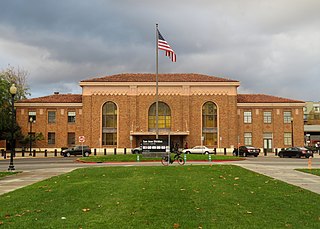
San Jose Diridon station is the central passenger rail depot for San Jose, California. It also serves as a major intermodal transit center for Santa Clara County and Silicon Valley. The station is named after former Santa Clara County Supervisor Rod Diridon Sr.

Santa Fe Depot is a union station in San Diego, California, built by the Atchison, Topeka and Santa Fe Railway to replace the small Victorian-style structure erected in 1887 for the California Southern Railroad Company. The Spanish Colonial Revival style station is listed on the National Register of Historic Places and is a San Diego Historic Landmark. Its architecture, particularly the signature twin domes, is often echoed in the design of modern buildings in downtown San Diego.

16th Street station is a former Southern Pacific Railroad station in the Prescott neighborhood of Oakland, California, United States. The Beaux-Arts building was designed by architect Jarvis Hunt, a preeminent railroad station architect, and opened in 1912. The station has not been served by trains since 1994.

The Fullerton Transportation Center is a passenger rail and bus station located in Fullerton, California, United States.

Palo Alto station is an intermodal transit center in Palo Alto, California. It is served by Caltrain regional rail service, SamTrans and Santa Clara VTA local bus service, Dumbarton Express regional bus service, the Stanford University Marguerite Shuttle, and several local shuttle services. Palo Alto is the second-busiest Caltrain station after San Francisco, averaging 7,764 weekday boardings by a 2018 count. The Caltrain station has two side platforms serving the two tracks of the Peninsula Subdivision and a nearby bus transfer plaza.
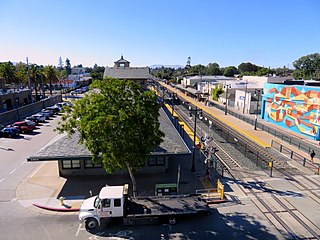
San Mateo station is the northernmost of the three Caltrain stations in San Mateo, California. It is in downtown San Mateo.

Gilroy station is a Caltrain station located in Gilroy, California, United States. It is the southern terminus of the South County Connector service, and is only served during weekday rush hours in the peak direction, with trains going toward San Jose in the morning and returning southbound in the evening. The station building was constructed by the Southern Pacific Railroad in 1918 and restored in 1998. Future plans call for extended Amtrak Capitol Corridor service, as well as California High-Speed Rail trains, to also stop at Gilroy. The station was named to the National Register of Historic Places in 2019 as Gilroy Southern Pacific Railroad Depot.
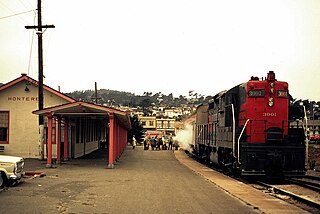
The Del Monte was a passenger train operated by the Southern Pacific Railroad between San Francisco and Monterey, California. It ran from 1889 to 1971.

Salinas station, also known as the Salinas Intermodal Transportation Center, is an intermodal transit center in downtown Salinas, California, United States. As a transit hub, the facility is a passenger rail station and bus station.
Del Monte is a district of Monterey, California. It was formerly an independent unincorporated community in Monterey County. It is located in the east part of Monterey, at an elevation of 16 feet.
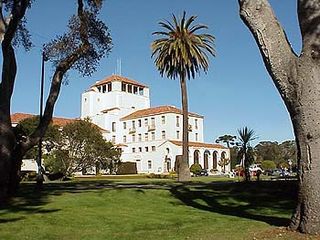
The Hotel Del Monte was a large resort hotel in Monterey, California, from its opening in 1880 until 1942. It was one of the finest luxury hotels in North America. During World War II, it closed and the building was leased to the United States Navy. It first was used by the Navy as a school where enlisted men spent the second, third, and fourth months of an 11-month course being trained as electronic technicians. Later the Hotel Del Monte became the Naval Postgraduate School.

The Third and Townsend Depot was the main train station in the city of San Francisco for much of the first three quarters of the 20th century. The station at Third Street and Townsend Street served as the northern terminus for Southern Pacific's Peninsula Commute line between San Francisco and San Jose and long-distance trains between San Francisco and Los Angeles via the Southern Pacific's Coast Line. For service for destinations to the north, such as Seattle, and destinations to the east, such as Chicago, passengers generally needed to travel to Oakland, initially on ferries to Oakland Long Wharf, and later on buses to 16th Street Station. It was demolished in the 1970s and replaced by the Caltrain commuter station a block away at Fourth and King Streets.

Monterey station was a train station in Monterey, California located close to Fisherman's Wharf. Originally served by the Monterey & Salinas Valley Railroad, the line was purchased by Southern Pacific on September 29, 1879. Southern Pacific constructed a new station building in 1921. Train service ended with the cancellation of the Del Monte after April 30, 1971, when Amtrak took over passenger rail services in the United States.
Pajaro/Watsonville is a proposed train station that will serve both Pajaro and Watsonville, California. The station is expected to open after track improvements in the area and service commences to Salinas as part of the Monterey County Rail Extension. It will be located in Watsonville Junction near the corner of Salinas Road and Lewis Road, adjacent to the former Southern Pacific Railroad depot and current Union Pacific Railroad office. The station will eventually serve Caltrain, Capitol Corridor, and Coast Starlight. Construction of the station is expected to begin in 2027.
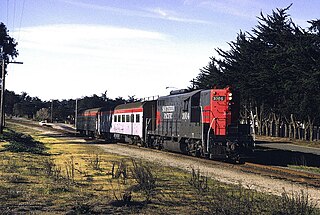
The Monterey Branch Line is a railway line located in Monterey County, California. It runs 16 miles (26 km) between Castroville, where it connects to the Union Pacific Coast Line, and Monterey, formerly running as far as Pacific Grove. It is roughly paralleled by California State Route 1.

St. John's Chapel, Del Monte is a parish of the Diocese of El Camino Real Episcopal Church in Monterey, California, founded in 1891. Intended for guests at the Hotel Del Monte, the property was donated by railroad tycoon Charles Crocker. St. John's Chapel is an example of an Episcopal church designed by architect Ernest Coxhead, with his shingle style architecture. The Chapel was listed on the National Register of Historic Places on October 21, 2020.
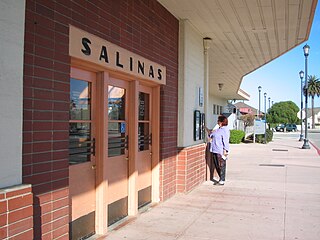
The Monterey County Rail Extension is a planned commuter rail extension that would bring Caltrain passenger service south of its existing Gilroy, California terminus to Salinas in Monterey County, using the existing Coast Line owned by Union Pacific (UPRR). Implementation of the rail extension will occur over three phases, starting from Salinas and moving north. When construction is complete, there will be four trains operated over the extended line per weekday: two northbound trains that depart from Salinas and travel to San Francisco in the morning, and two southbound trains that return to Salinas in the afternoon.

Coyote station was a railroad depot in Coyote, California, United States. Established in 1869, the station was part of the Southern Pacific Railroad's first line connecting San José and Gilroy. Located in the heart of the Coyote Valley, the depot took its name from the Coyote Creek and explorer Juan Bautista de Anza who referred to the area as "Arroyo del Coyote." The train station was in use until the cancellation of the train route in 1959. Recently, in May 2024, Coyote station was relocated to History Park at Kelley Park in San José. The building will be restored and made into a transportation museum.


















